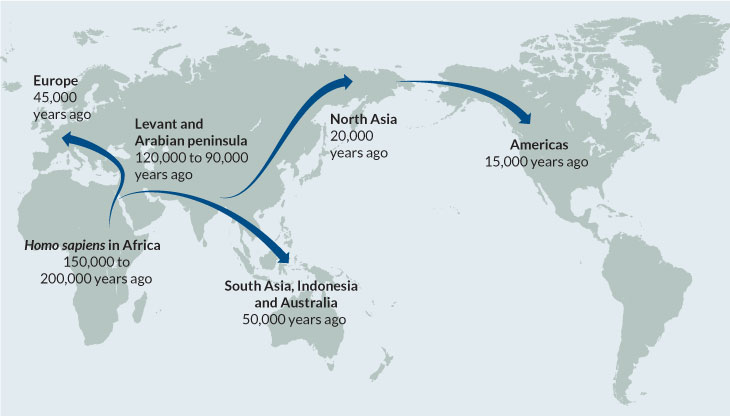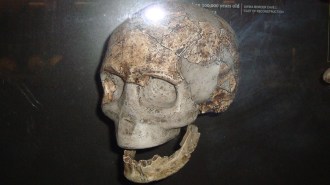Year in review: How humans populated the globe
Genetic studies offer new insights into the ancient exodus out of Africa

GENETIC JOURNEY Recent genetic analyses suggest that natives of Papua New Guinea, shown here during a traditional Enga cultural show in 2015, descend from people who left their Africa homeland some 72,000 years ago.
Michal Knitl/Shutterstock
![]() No paper or digital trails document ancient humans’ journey out of Africa to points around the globe. Fortunately, those intrepid travelers left a DNA trail. Genetic studies released in 2016 put a new molecular spin on humans’ long-ago migrations. These investigations also underscore the long trek ahead for scientists trying to reconstruct Stone Age road trips.
No paper or digital trails document ancient humans’ journey out of Africa to points around the globe. Fortunately, those intrepid travelers left a DNA trail. Genetic studies released in 2016 put a new molecular spin on humans’ long-ago migrations. These investigations also underscore the long trek ahead for scientists trying to reconstruct Stone Age road trips.
“I’m beginning to suspect that the ancient out-of-Africa process was complex, involving several migrations and subsequent extinctions,” says evolutionary geneticist Carles Lalueza-Fox of the Institute of Evolutionary Biology in Barcelona.
Untangling those comings, goings and dead ends increasingly looks like a collaborative job for related lines of evolutionary research — comparisons of DNA differences across populations of present-day people, DNA samples retrieved from the bones of ancient hominids, archaeological evidence, fossil finds and studies of ancient climates. It’s still hard to say when the clouds will part and a clear picture of humankind’s journey out of Africa will appear. Consider four papers published in October that featured intriguing and sometimes contradictory results.
Three new studies expanded the list of present-day populations whose DNA has been analyzed. The results suggest that most non-Africans have inherited genes from people who left Africa in a single pulse between about 75,000 and 50,000 years ago (SN: 10/15/16, p. 6). One team, studying DNA from 142 distinct human populations, proposed that African migrants interbred with Neandertals in the Middle East before splitting into groups that headed into Europe or Asia. Other scientists whose dataset included 148 populations concluded that a big move out of Africa during that time period erased most genetic traces of a smaller exodus around 120,000 years ago. A third paper found that aboriginal Australians and New Guinea’s native Papuans descend from a distinctive mix of Eurasian populations that, like ancestors of other living non-Africans, trace back to Africans who left their homeland around 72,000 years ago.
The timing of those migrations may be off, however. A fourth study, based on climate and sea level data, identified the period from 72,000 to 60,000 years ago as a time when deserts largely blocked travel out of Africa. Computer models suggested several favorable periods for intercontinental travel, including one starting around 59,000 years ago. But archaeological finds suggest that humans had already spread across Asia by that time.
Story continues below map.

Clashing estimates of when ancient people left Africa should come as no surprise. To gauge the timing of these migrations, scientists have to choose a rate at which changes in DNA accumulate over time. Evolutionary geneticist Swapan Mallick of Harvard Medical School and the other authors of one of the new genetics papers say that the actual mutation rate could be 30 percent higher or lower than the mutation rate they used. Undetermined levels of interbreeding with now-extinct hominid species other than Neandertals may also complicate efforts to retrace humankind’s genetic history (SN: 10/15/16, p. 22), as would mating between Africans and populations that made return trips.
“This can be clarified, to some extent, with genetic data from ancient people involved in out-of-Africa migrations,” says Lalueza-Fox. So far, though, no such data exist.
The uncertainty highlights the need for more archaeological evidence. Though sites exist in Africa and Europe dating from more than 100,000 years ago to 10,000 years ago, little is known about human excursions into the Arabian Peninsula and the rest of Asia. Uncovering more bones, tools and cultural objects will help fill in the picture of how humans traveled, and what key evolutionary transitions occurred along the way.
Mallick’s team has suggested, for example, that symbolic and ritual behavior mushroomed around 50,000 years ago, in the later part of the Stone Age, due to cultural changes rather than genetic changes. Some archaeologists have proposed that genetic changes must have enabled the flourishing of personal ornaments and artifacts that might have been used in rituals. But comparisons of present-day human DNA to that of Neandertals and extinct Asian hominids called Denisovans don’t support that idea. Instead, another camp argues, humans may have been capable of these behaviors some 200,000 years ago.
Nicholas Conard, an archaeologist at the University of Tübingen in Germany, approaches the findings cautiously. “I do not assume that interpretations of the genetic data are right,” he says. Such reconstructions have been revised and corrected many times over the last couple of decades, which is how “a healthy scientific field moves forward,” Conard adds. Collaborations connecting DNA findings to archaeological discoveries are most likely to produce unexpected insights into where we come from and who we are.






